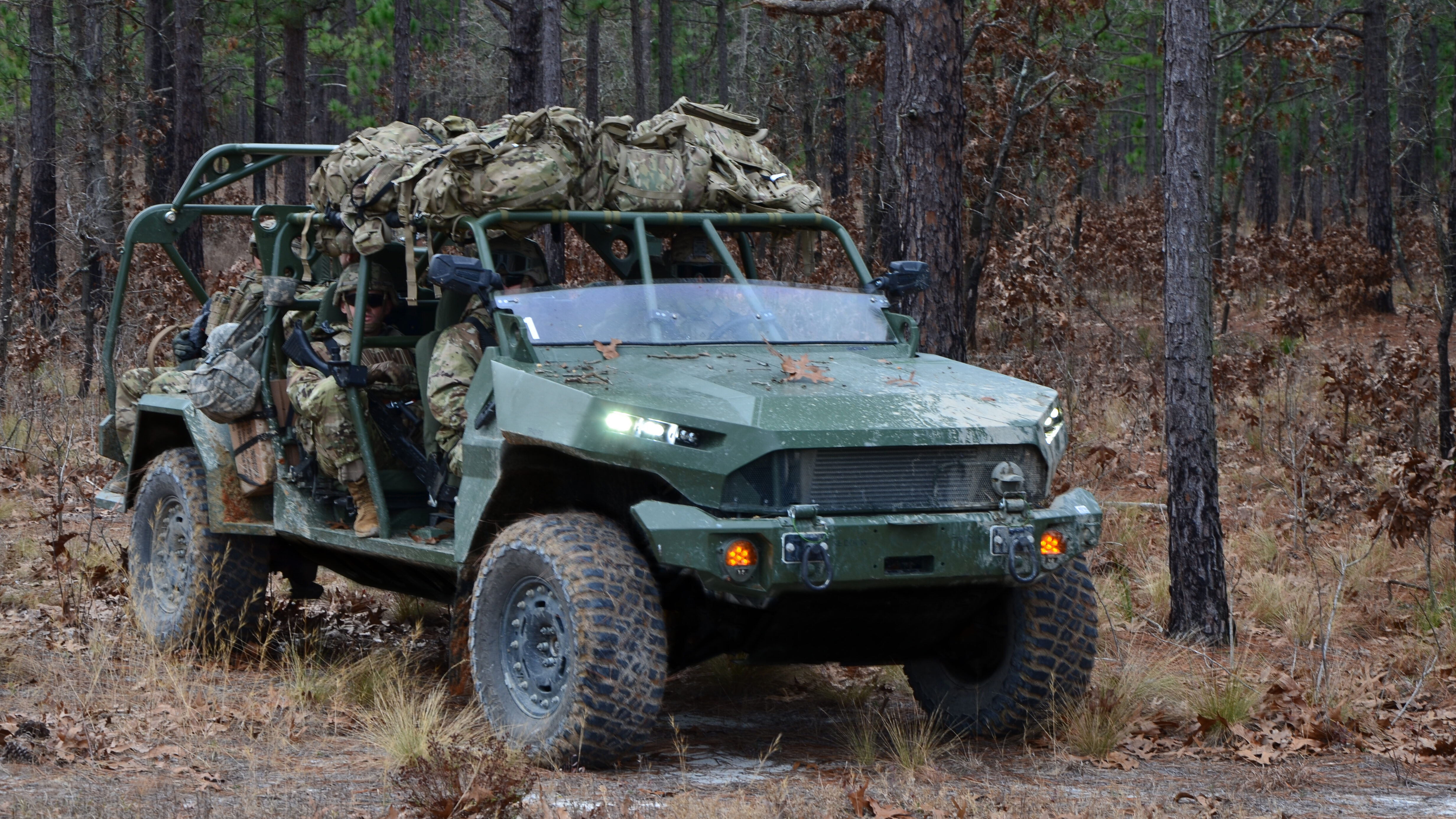
GM Defense has its sights on other targets like the Army’s Joint Light Tactical Vehicle program. The company is building the Infantry Squad Vehicle for the Army. (GM Defense)
AUSA: Four years after General Motors reentered the military market, the company’s new defense business leader believes a string of awards shows that its strategy of leaning on its commercial derivatives has positioned GM Defense for long-term success.
Now, with a series of wins under its belt, company leadership is aiming to leverage its commercial investments to corner the market for a Pentagon priority — the shift into electric vehicles.
The subsidiary netted its biggest win so far with 2020’s $214 million contract for the Army’s infantry squad vehicle, a light utility vehicle derived from the Chevrolet Colorado ZR2 midsize truck on its commercial side. The defense division also recently racked up a small development contract for 10 heavy duty SUVs for the State Department’s Diplomatic Security Service, a contract that could lead to a production contract in the future and whose design is based on the commercial side’s Suburban.
According to Steve duMont, president of GM Defense, it’s evidence that the defense subsidiary’s growth plan to tap into GM’s commercial vehicle design is working despite a 13 year absence from the defense sector.
“That speed that we deliver — it is a fundamental and instrumental part of the value that we’ll bring to the defense and government market,” duMont told Breaking Defense in an interview. His prime example is the delivery of the first several ISVs to the Army within 120 days of the contract award, a speed rarely heard of defense procurement.
Those wins were enough to justify GM’s decision to relaunch its defense business, but the electric vehicle market may provide a next-level opportunity. The parent company has pledged to invest $35 billion through 2025 for investments in electric and autonomous vehicles, including standing up two new battery plants — a kind of investment few defense firms would be able to make, thanks to the commercial marketplace for electric vehicles.
GM Defense can coast off those investments when competing for upcoming contracts, starting with the Army’s electric light reconnaissance vehicle. GM Defense will take the chassis of the all-electric Hummer, heading to commercial dealerships over the next year, and design it to fit the Army’s needs from there.
“The more that we can adaptively engineer commercial technology to deliver military systems that meet the requirements of our defense and government customers, but not require us from the ground up to design a new vehicle — where I think we really get into this disruptive, deliver quickly and deliver technology at the speed of relevance,” duMont said.
There are other prototype efforts in play; earlier this year, the company put an electric motor in a new variation of the Infantry Squad Vehicle and let soldiers drive it at Fort Benning, Ga. DuMont said soldiers tested many pieces of the electric version, including measuring the acoustic and thermal signatures of the vehicles.
While reducing carbon emissions is a good thing overall, and in line with climate efforts from the Biden administration, the Pentagon sees more tactical benefits. In addition to reducing the need for supply chains – often the weakest point in an operational plan – electric vehicles offer near silence, which is particularly useful for surveillance and overwatch missions.
“If you look at the tactical benefit, electric vehicles are incredibly acoustically silent,” duMont said. “They’re very low acoustic signature, they generate a very low thermal signature. Most targeting systems still use infrared tracking devices to target vehicles. … We’re starting to see a lot of focus on the tactical advantage of the path to electrification”
Exploring how to add – and even convince – the military to add electric power to their vehicles is a challenge itself with difficulties around how to get and charge in a disconnected environment. Right now, duMont said there’s “a lot of focus” on extending the range of electric vehicles, while adding it currently has similar “if not greater” range than internal combustion engines. DuMont also said that the other big discussion at GM Defense is about tactical recharging.
“We’re focusing a lot of energy and effort and listening to warfighters in how we could best supply the recharged capability out at the tactical edge which will be an important element of this transformation.”
DuMont also said the company is actively working with unmanned aerial systems companies to make the drones lighter and more agile through electrification. He added that the company also exploring electriciation for surface and subsurface vehicles.
GM’s re-entry into the defense space comes at a pivotal moment as the Army prepares to fight multi-domain operations and the broader military builds out Joint All-Domain Command and Control, an effort to connect the best sensor to the best shooter to build an interconnected battlefield. As the Pentagon’s vision for its future warfighting concept slowly comes to fruition, GM Defense argues that it can harness its commercial counterpart’s investment in OnStar, GM’s built-in emergency service that connects 22 million vehicles back to GM, as its starting place to build each vehicle as a node on a network.
As for ongoing competitions for the Joint Light Tactical Vehicle recompete and the Optionally Manned Fighting Vehicle contract, duMont is actively looking for partners for GM Defense.
“In the areas where we bring a lot of value as an OEM [original equipment manufacturer], we’ll lead those,” duMont said. “And I think there’s lots of opportunity for General Motors Defense to bring amazing capability to companies that are now working in the combat vehicle space.”






















